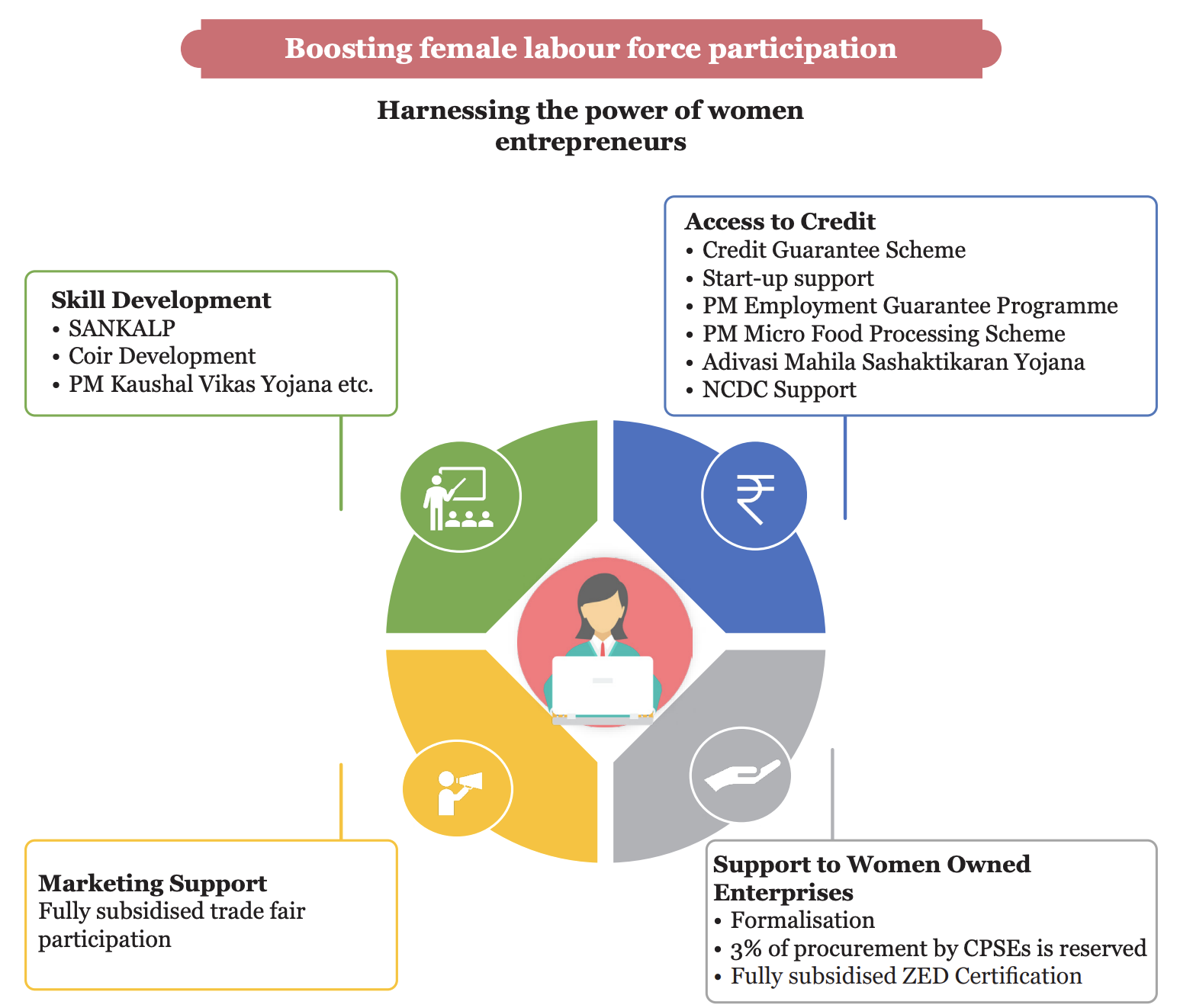Introduction
- With around 26 per cent of the population in the age group 10-24 years, India stands at the cusp of a once-in-a-lifetime demographic opportunity.
- India is poised to be the third largest economy by 2030, after the USA and China.
State of employment
- Unemployment rate declined to 3.2% in 2023-24 from 6.0% in 2017-18.
- Labour Force Participation Rate (LFPR) increased from 49.3% to 50.4%, and the Worker-to-Population Ratio (WPR) rose from 46% to 47.2% during the same period (Q2 of FY24 to Q2 FY25).
- The proportion of self-employed workers in workforce has risen from 52.2% (2017-18) to 58.4% (2023-24)
Sectoral distribution of the workforce
- The agriculture share rise from 44.1% in 2017-18 to 46.1% in 2023-24.(PLFS 2023-24)
- The manufacturing share fall from 12.1% to 11.4% and services from 31.1% to 29.7%.
Trends in Female LFPR
- Female LFPR has risen from 23.3% in 2017-18 to 41.7% in 2023-24
- Most states (21) have a FLFPR in the range of 30-40%.
- Seven states/ UTs reported FLFPR >40% in 2023-24, with Sikkim reporting the maximum rate of 56.9%

Trends in wages and earnings
- Average monthly earnings for regular wage/salaried workers and self-employed workers grew at a CAGR of 5% during 2018-19 to 2023-24.
- Daily wage of Casual workers increased at a CAGR of 9% in the same period.
- Rural wages: On average, nominal wage rate in agriculture grew by 5.7% for men and 7% for women.
- When adjusted for inflation, the real wage rate in agriculture demonstrated modest growth, increasing by 0.6 % for men and 1.8% for women.
- Corporate profitability soared to a 15-year peak in FY24: Profits climbed 22.3% in FY24, however employment grew by a mere 1.5%
Growing formal sector in India
- Net additions to EPFO subscriptions have more than doubled, rising from 61 lakh in FY19 to 131 lakh in FY24.
Welfare of Unorganised Workers
- eShram portal was launched to register and support unorganised workers.
- eShram– "One-Stop-Solution" was launched which entails the integration of different social security/ welfare schemes on a single portal.
Job creation: action towards enhanced employment opportunities
Security vs. Flexibility: The role of regulation in job creation
- Formulation of four Labour Codes, the Code on Wages, 2019; the Code on Social Security, 2020; the Industrial Relations Code, 2020; and the Occupational Safety, Health, and Working Conditions Code, 2020 will help in job creation because of simplification of laws.
Driving employment opportunities through the digital economy
- India's digital economy is projected to surpass USD one trillion by 2025.
- The gig workforce is projected to reach 23.5 crore by 2029-30, comprising 6.7% of the non-agricultural workforce and 4.1% of total livelihoods.
Building a green workforce: Job creation in the renewable energy sector
- An estimated 1.02 million jobs in 2023 in renewable sector with Hydropower being largest.(IRENA)
- Women's self-help groups (SHGs) will drive job creation including solar entrepreneurship.
- Climate-smart solutions that use Decentralized Renewable Energy (DRE) will lead to job creation.
- Challenges to Women Employment: Climate Change, Disasters, Gender-biased tools, limited financing, socio-cultural and geographic barriers.
Skill development: upskilling, reskilling and new skilling for a changing world
- 4.9% of the youth in the age cohort of 15-29 years have received formal vocational/technical training, while another 21.2% received training through informal sources (PLFS report 2023-24)
- PLFS data shows that 90.2 % of the workforce has equivalent to or less than a secondary level of education.
- 88.2 % of workforce are involved in low-competency occupations- elementary skilled and semi-skilled occupational skills.
Skilling for a changing world
- Reskilling & upskilling: Over 1.24 crore enrolled in Craftsmen Training Scheme at Industrial Training Institutes (ITIs), PMKVY: 1.57 Cr trained; 1.21 Cr certified (Short-Term Training (STT), Special Projects (SP), and Recognition of Prior Learning (RPL)).
- Women Participation: Under PMKVY Women's participation is 58 % (FY25);
- New age & future skills: National Council for Vocational Education and Training: 200+ new-age & future skill courses approved, Tiered skill framework (Foundational, Intermediate, Advanced) with AI skills.
- Industry partnerships: New ITI Upgradation Scheme (2024) with upgrade of 1,000 ITIs in hub-and-spoke, PM Internship Scheme.
- Digital public infrastructure for skilling: Skill India Digital Hub Portal, Democratising Skills with Easy access to industry-aligned courses.
Conclusion
- By simplifying compliance, fostering labour flexibility, and promoting worker welfare, labour reforms have created an enabling environment that balances ease of doing business with the protection of worker rights. This fosters a 'virtuous cycle of job creation,' supporting sustainable employment growth and economic inclusivity.
One-Line Summary:India's employment and skill development strategies focus on formalization, digital skilling, and workforce participation, but job creation must accelerate to match demographic expansion. |
Relevance for UPSC:
|


